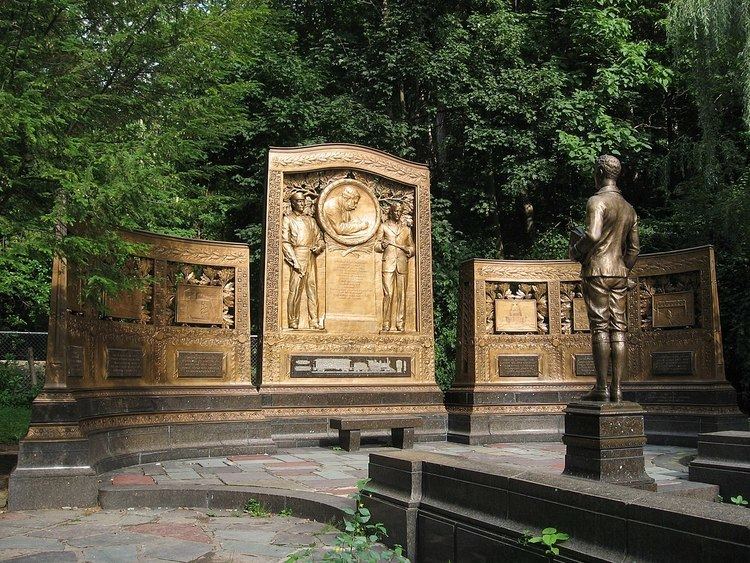Opening date 6 October 1930 Phone +1 412-682-7275 | Opened 6 October 1930 | |
 | ||
Material Bronze, Norwegian granite Address W Circuit Rd, Pittsburgh, PA 15217, USA Hours Open today · Open 24 hoursSaturdayOpen 24 hoursSundayOpen 24 hoursMondayOpen 24 hoursTuesdayOpen 24 hoursWednesdayOpen 24 hoursThursdayOpen 24 hoursFridayOpen 24 hoursSuggest an edit Similar Schenley Park, George Westinghouse Bridge, Panther Hollow Bridge, August Wilson Park, Mellon Park | ||
Westinghouse memorial history and restoration
The Westinghouse Memorial is a bronze monument located in the U.S. city of Pittsburgh, Pennsylvania. It commemorates George Westinghouse, an engineer and inventor of the railway air brake. The memorial is located at the entrance to the Steven Faloon trail, a part of Schenley Park. The architects for the monument and the surrounding area were Henry Hornbostel and Eric Fisherwood. Daniel Chester French was the sculptor for the statue and the main panel, and Paul Fjelde designed the side panels.
Contents
- Westinghouse memorial history and restoration
- Marky westinghouse memorial video
- History
- Design
- Three panels
- The Spirit of the American Youth
- Lily pond and surrounding landscape
- References
The memorial consists of a statue of a schoolboy, who represents "The Spirit of the American Youth". He looks on at three panels that represent the life of George Westinghouse and is presumed to draw inspiration from them. The memorial is made of bronze and granite. It is one of many mementos to George Westinghouse in the area. Some additional honors include Westinghouse Park, George Westinghouse Memorial Bridge, and the George Westinghouse, Jr., Birthplace and Boyhood Home.
The current location of the memorial is near the back of Carnegie Mellon University in the Squirrel Hill neighborhood of Pittsburgh. Schenley Drive, a road that run through the park, is also nearby.
Marky westinghouse memorial video
History
The memorial was financed from $200,000 in donations made by approximately 55,000 workers of Westinghouse companies in electricity. It was dedicated on 6 October 1930. There opening ceremony was attended by over 10,000 people, including U.S. Representative James F. Burke and Pittsburgh mayor Charles H. Kline, and a celebratory dinner was held the night before at the William Penn Hotel. The memorial was on the original site of the Pittsburgh Zoo, which has since been relocated to an area near Highland Park. The bronze memorial was originally covered in gold leaf, which was removed in 1941 due to vandalism.
The Westinghouse Foundation paid for the memorial's restoration in 1986 in honor of the centennial of Westinghouse Electric.
The pond was drained in 2009 due to irreparable water damage. Donations were collected to restore the pond and surrounding area of the memorial.
Design
The original memorial consisted of three double-sided panels arranged in a semi-circle that depict the life of George Westinghouse, a statue of a school-age boy facing the panels, and the surrounding natural landscape including a lily pond and black granite benches.
Three panels
The three panels sit on top of a Norwegian granite base. The main panel depicts George Westinghouse with an engineer and a mechanic on either side of him.
The dedication plaque reads:
The backs of the panels maintain the same full details of the front. They also feature the names Masaniello Piccirilli, one of the Piccirilli Brothers, Daniel Chester French, and Paul Fjelde.
The Spirit of the American Youth
The statue part of the memorial features a young American boy who represents The Spirit of the American Youth. He stands facing the wall dedicated to George Westinghouse, and is supposed to take inspiration from the other man's life. The boys carries books in one arm and a hat in the other. The statue has been vandalized by spray paint in the past.
Lily pond and surrounding landscape
Cherry trees were dedicated on its opening in 1931 and again in 1965.
There is currently an empty pond that once held a natural body of water from the Phipps Run stream that fed to Panther Hollow Lake. After this natural pond was damaged, it was maintained by channeling water to the area through a pipe. A fountain was installed in the pond to increase water circulation. Drinking water had also been used to fill the pond. Eventually the basin of the pond was damaged beyond repair, and the pond was finally drained in 2009.
Since 2011, there have been plans to restore the pond. Pittsburgh Parks Conservancy is the main group collecting donations for this purpose. The restoration would create a new pond, add lighting, and make the area wheelchair accessible.
